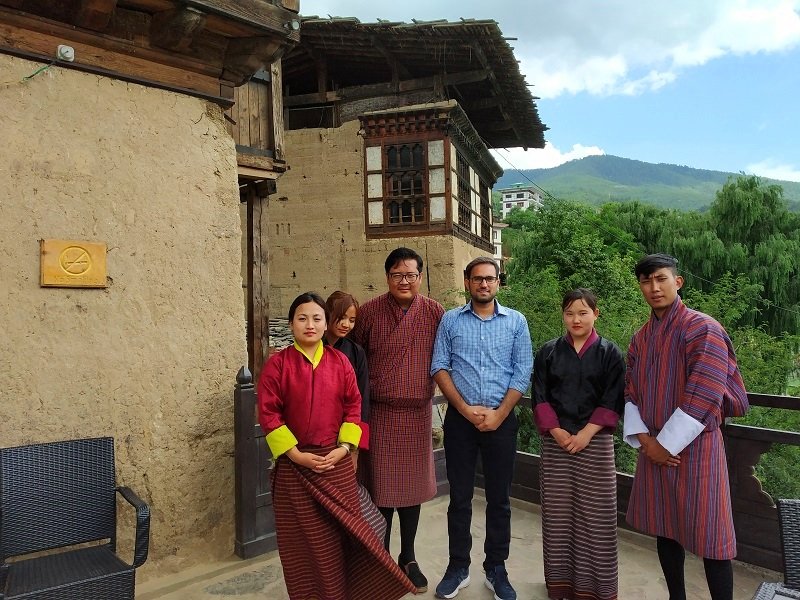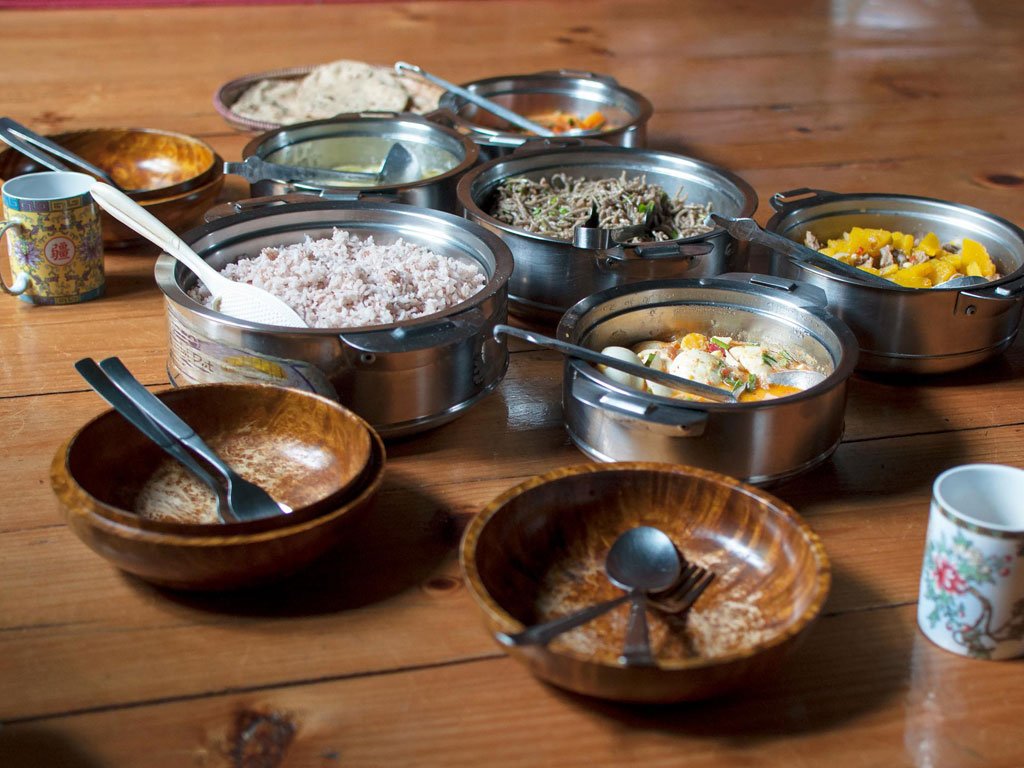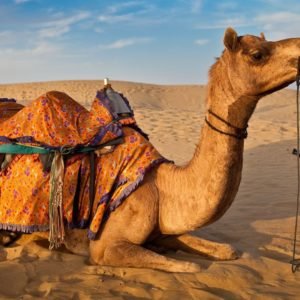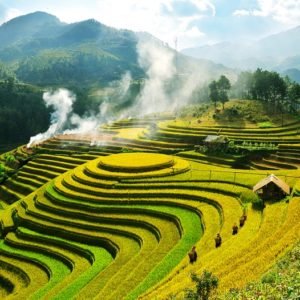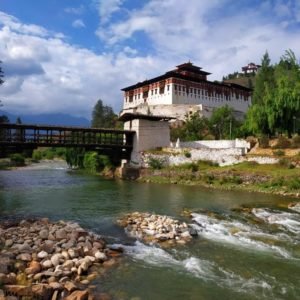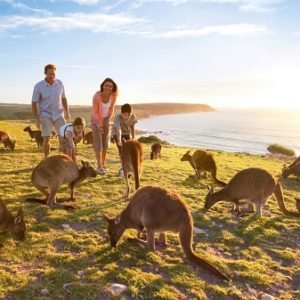Day 01: Paro – Thimphu (L/D)
Distance: 51 kms
Estimated travel time: 1:20 hrs
Arrive into Paro. The Flight to Paro is one of the most spectacular mountain flights in the world, with a constantly changing panorama of some of the highest mountains on earth. On arrival at Paro airport, after completion of immigration and custom formalities our representative will receive and drive you to Thimphu, the capital of Bhutan.
After lunch if time permits visit the following:
- The Memorial Chorten which was constructed in 1974 as a memorial for the third King of the country, King Jigme Dorji Wangchuck, who is widely regarded as the father of modern Bhutan.
- Tashichhoe Dzong, a fortress of the glorious religion. It was built in 1641 by Zhabdrung Ngawang Namgyel and was reconstructed into present structure by the late King, His majesty Jigme Dorji Wangchuck in the year 1962-1969. It houses the secretariat building, the throne room and the office of the king, and the central monk body.
In the evening stroll around Thimphu town and you may visit local handicraft stores.
Today during dinner, you will try your first Bhutanese dish at Babesa Village restaurant, a 500 year old traditional house which is later transformed into a restaurant serving authentic traditional Bhutanese cuisine.
Overnight in Thimphu.
Day 02: Thimphu (B/L/D)
After having breakfast at the hotel, first visit:
- The School of Traditional Painting of Arts and Crafts where students undertake a six-year course on the 13 traditional arts and crafts of Bhutan.
- The Folk Heritage Museum, an outdoor museum that gives an insight into rural life in Bhutan.
- Takin Preserve, which houses the national animal Takin (Budorcastaxicolor white) the national animal of Bhutan
- Kuenselphodrang where largest Buddha statue in the country is perched on the hillock overlooking the Thimphu valley and also if interested/if time permits, take a leisure walk through Kuenselphodrang Nature Park and enjoy the nice view of the entire Thimphu valley below.
During Lunch you will go to a very popular restaurant among locals called the Zombala Restaurant. The specialty of this restaurant are dumplings or in Bhutan we call them as “momo”. This restaurant was so popular with the local people that they have now opened up another restaurant called Zombala 2 in the city. Among momos, this place have other dishes like Thukpa( noodle soup), fried rice, shabalay( meat stuffed bun) and many more.
After Lunch visit:
- Centenary Farmers’ market (if tour coincides with Thu-Sun) where farmers would be selling their wide range of farm produces (vegetables from farms and wild ferns or bamboo shoots collected from forest, flour, rice, roasted rice, rice flakes, spices, yams both cultivated and wild ones collected from forests, fruits, etc) and livestock products (mainly cheese and butter). Free interaction with people from town as well as from villages come to this weekend market. Weekend market is from Thursday-Sunday(4 days).
- Archery Match (National game of Bhutan): During the visit drop by at one of the archery field to watch locals play archery. (sometimes you won’t be able to see as it depends on the season and tournaments of archery)
- Post office, where you can buy different types of Bhutanese stamps and also make your own personal Bhutan stamps using your pictures.
Today you will visit a house of a local Bhutanese family and learn how to cook one of the local dishes of western Bhutan called memja/ mengay. And also, can help the family with preparing dinner. Later have dinner with the family and can chat with them to better understand a Bhutanese day to day life.
As most Bhutanese family have early dinner, if you are interested you can visit local bars to try out Bhutanese beers and also experience the night life of Bhutan. (In Bhutan the night life is only lively during Fridays and Saturdays.)
Overnight in Thimphu.
Day 03:Thimphu – Gangtey (B/L/D)
Distance: 140 kms
Estimated travel time: 04 hrs
After breakfast drive to the glacial valley of Phobjikha. At Gangtey visit great monastery of Gangtey, Gantey Goempa established in the 17th century and the black neck crane center. This remote valley is the winter home of the black necked cranes who fly from Tibet. Explore Gangtey village and Phobjikha valley. After reaching there do the Gangtey Nature Trail-A pleasurable walk (around 2 hours) that gives a nice feeling for Phobjikha valley. It is the most beautiful and shortest of the existing nature trails in Bhutan. From the small hilltop overlooking Gangtey Goemba, head downhill through flower meadows to Semchubara village and from here through beautiful forests and into the open valley. Also visit the black necked crane center to understand more about these beautiful birds.
For Lunch visit Galkiling hotel to try their one of the best roasted potatoes all over Bhutan.
For dinner visit a local farm house and can see how they cook and eat in the rural areas. Most elderly people in the rural areas don’t know how to speak English but more than 90% of the youths can speak so you can have a chat with them after dinner to better understand how they live.
Overnight at Phojikha.
Day 04: Gangtey – Punakha (B/L/D)
After breakfast drive to Punakha and visit the Devine Madman’s Monastery-Chhimi Lhakhang, famously known for its fertility shrine, where couples unable to conceive come here for blessing.
Later visit the Punakha Dzong, Placed strategically at the junction of the Pho Chu and Mo Chu rivers; the Dzong was built in the 17th century by Zhabdrung Ngawang Namgyal to serve as the religious and administrative seat of the region. It was here that the dual system of government was introduced and in 1907, enthroned the first King Gongsar Ugyen Wangchuck. Damaged over the centuries by four catastrophic fires and an earthquake, the dzong has been fully restored in the recent years by the 4th King Jigme Singye Wangchuck. At the Dzong enrich your trip with the opportunity to see the highest standards in woodwork. Do not miss the massive Kuenray, the Coronation Hall of all Bhutanese kings, the Dzongchung at the entrance to the dzong and the cantilever bridge over the Mochu that has been recently renovated. Just few minutes drive from the Dzong you will go visit the longest suspension bridge in Bhutan. This 160 metres suspension bridge is the longest in Bhutan. The bridge is stable and provides a good view of the river and valley, with the mountain as background.
Overnight at the hotel.
Day 05: Punakha – Paro (B/L/D)
Distance: 127 kms
Estimated travel time: 3: 30 hrs
Today early morning Hike to the Khamsum Yuley Temple. There is no temple in Bhutan built elaborately as this. This fascinating temple was built by the Queen Mother of the 5th King to bring universal peace in this world. The best of the spiritual art works are painted on the inner walls. There are also paintings of Buddhist teachers and tutelary deities of the country. This is a great temple to study the symbolic meanings from frescoes and sculptures. After the hike drive back to Paro via Thimphu. You will have your lunch at Thimphu. Today for lunch you will visit a restaurant called seasons restaurant where they serve pizza and many other western cusines such as pasta, burger, chicker wings etc..to experience the taste of Bhutansese take on western foods.
After lunch drive to Paro. At Paro visit Paro Dzong, a fine example of Bhutanese historic architecture. It is also known as the RinpungDzongwhich means a “fortress that sits on a heap of jewels”. This imposing dzonglocated above the Paro river is a fine example of Bhutanese architecture with its inward sloping walls that rise to an impressive height.Thedzongwas built in the 16th century on the foundation of a monastery built by Guru Rinpoche (who is regarded as the “second Buddha.”) .From the Dzong, walk further down to NyamaiZampa, an oldest traditional cantilever bridge in Bhutanand also visit the National Museum which is now being housed at a hall near the Ta Dzong (National Musuem) as it is now closed to the visitors due to major cracks formed during the September 2011 earthquake that hit Bhutan quite hard.
In the evening stroll around the Paro town, free mingle with people and do shopping.
After dinner at a local tourist restaurant where they serve mixed fusion of western and Chinese cusines where most tourist are taken for meals, visit the Namgay artisanal Bistro or NAB to taste the local unique beer made out of red rice.
Overnight at a hotel in Paro.
Day 06: Paro (Taktsang Hike) (B/L/D)
Today you will hike to Taktsang Goempa(Tiger’s Nest Monastery), the most famous tourist destination in Bhutan. It takes around 30minutes drive from Paro town to the Parking lot. The hike upto the viewpoint will take about 1 1/2 hours from the parking lot and from there you will enjoy a spectacular view of the monastery clinging to the side of the cliff.You will stop here for refreshments and then hike further upto the monastery which should take another 1 1/2 hours. It was first built in 1692, around the Taktsang SengeSamdup, a cave where Guru Padmasambhava is said to have meditated for three months in the 8th century. It is believed that Guru Rinpoche (Guru Padmasambhava) flew to this location from Khenpajong, Tibet on the back of a tigress and subdued a demon. He then performed meditation in one of the caves here and emerged in eight incarnated forms (manifestations) and blessed the place. Subsequently, the place came to be known as the “Tiger’s Nest”. Guru Padmasambhava is known for introducing Buddhism to Bhutan. Today, Paro Taktsang is the best known of the thirteen caves in which he meditated. After visiting the monastery, walk back downhill to the road with lunch at the viewpoint cafeteria.
Later visit Kichutemple, one of the 108 temples built in the 7th century by the Tibetan King SongstenGampo. The story goes that a giant demon lay across the whole area of Tibet and the Himalayas and was preventing the spread of Buddhism. To overcome her, King SongtsenGampo decided to build 108 temples, which would be placed on all the points of her body. Of these 108 temples, 12 were built in accordance with precise plans. Thus, it happened that in about the year AD 638 the temple of Jokhang in Lhasa was built over the very heart of the demon.)
In the evening visit a local farm house where you will have a cooking class on how to make momos and popular Bhutanese dishes like emadatsi (Chilli cheese).
Overnight at Paro.
Day 07: Paro (B)
After breakfast our guide will drop you to Paro Airport for your onward journey.
Hotels Used (4*):
Thimphu – Norkhil Boutique (Classic Room)
Punakha- RKPO Green Resort (Deluxe Room)
Gangtey- RKPO Green Resort (Deluxe Room)
Paro – Naksel Boutique (Superior Room)
The above cost Includes:
- Accommodation in Hotels as mentioned above on Twin share including breakfast
- All the sightseeing/ tours and transfers as per the itinerary
- Lunch and Dinner as per the itinerary
- All transportation services in a comfortable private vehicle as per the above program
- English Speaking knowledgeable guide for the whole tour
- Bhutan Visa fee
- Entrance fee in monuments, Parks, etc where applicable
- 02 bottle of mineral water per person/day in vehicle
The above cost Excludes:
- Airfares for both International and domestic sector
- Travel/Medical Insurance
- Items of personal nature such as bar bills, alcoholic beverages, laundry, telephone calls, extra mileage, personal gratuities as tips to guide, porters, drivers etc
- Personal insurance policy – suggested a comprehensive travel insurance covering tour and flight cancellations, loss of valuables, thefts, illness, accidents and hospitalization
- Excess baggage
- Any items not mentioned in the cost includes

